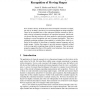Free Online Productivity Tools
i2Speak
i2Symbol
i2OCR
iTex2Img
iWeb2Print
iWeb2Shot
i2Type
iPdf2Split
iPdf2Merge
i2Bopomofo
i2Arabic
i2Style
i2Image
i2PDF
iLatex2Rtf
Sci2ools
BMVC
2001
2001
Zernike Velocity Moments for Description and Recognition of Moving Shapes
New Zernike velocity moments have been developed to describe an object, not only by its shape , but also by its motion throughout an image sequence. These are an extended form of the orthogonal Zernike moment set and include velocity information introduced via centralised moments. Initial analysis shows that they perform well when applied to analysing gait sequences resulting in a good recognition rate and a compact description. They have exhibited promising attributes when applied to occluded data, which is reflected in the method of describing a complete temporal sequence and not single images. Further, they appear to provide measures intimately related to the moving and/or morphing shape within the sequence. Their invariance properties suggest that they will be useful in real situations where poor quality or camera zoom problems are apparent.
BMVC 2001 | Complete Temporal Sequence | Computer Vision | Orthogonal Zernike Moment | Zernike Velocity Moments |
| Added | 30 Sep 2010 |
| Updated | 30 Sep 2010 |
| Type | Conference |
| Year | 2001 |
| Where | BMVC |
| Authors | Jamie D. Shutler, Mark S. Nixon |
Comments (0)

